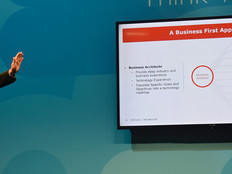The 3 Organizing Principles of Digital Transformation
Why is it important for organizations to embrace digital transformation? Ask anyone who used to make their living running a video store, selling encyclopedias or driving a taxi.
Consumer demands haven’t changed much: People still watch movies at home, look up information on obscure topics and need rides around town. But the companies that identified early on how technology would change these industries (Netflix, Google and Uber, among others) are now dominating these sectors.
“The real challenge is how to help your organization align the answers between what business you’re currently in and who you want your customers to become,” says Michael Schrage, research fellow at the MIT Center for Digital Business. “That requires you to think about innovation as something beyond what will make your products or services faster and better. You also need to think about who you want your customers to become and how new technology transforms your customers, not just your business.”
With so many emerging technologies in the marketplace today — often touted as “disruptive” and “transformative” — it can be difficult for executives to discern which will have a tangible impact on the future of their organizations and which will prove to be overhyped.
Schrage offers three organizing principles to help guide organizational strategies around digital transformation: innovations to human capital investments, design of data-driven virtuous cycles and the alignment of application programming interface (API) capabilities.
1. Focus on Both Employees and Customers
“If you’re wondering how to collaborate to create more valuable innovation,” says Schrage, “you should begin by asking a new question: ‘How can innovation create more valuable people?’”
The “people” Schrage is talking about include both employees and customers. Of course, technology can dramatically increase productivity among users, allowing them to perform key aspects of their jobs more quickly while often simultaneously improving the quality of their work. But Schrage says enterprises should also try to use technology to create “better customers.”
“We want to use technology not just to help people do a better job at work, or have a better user experience,” Schrage says. “We want to enable them to do better jobs and have better user experiences in ways that make them more valuable to the business, and make the business more valuable to them.”
Schrage says examples of this approach can be found throughout history, including the first mass production of automobiles. Henry Ford didn’t just introduce affordable vehicles to America, Schrage argues; Ford also essentially taught the entire country how to drive.
“I believe the most important innovation [by Ford] was not the mass production of automobiles,” Schrage says. “It was the mass production of driving, the human capital of driving.”
For a more recent — and almost as ubiquitous — example, Schrage points to Google. “What makes Google work?” Schrage asks. “The page rank algorithm. Google doesn’t just search. It creates searchers. Google may be in the search business, but what Google has effectively done is cultivated and harvested the human capital of its users. Everybody essentially works for Google, and they like it.”
2. Squeeze Value Out of Your Data
As mobile applications, Internet of Things (IoT) technologies, wearable devices and other digital tools create exponentially more data, organizations risk becoming bogged down with data management processes that don’t create significant value.
“Don’t ask the old IT question, ‘How do we manage 100 times more data?’” Schrage says. “Instead, ask, ‘How do we get the value out of 100 times more data?’”
That value, Schrage says, is often the result of a “virtuous cycle” — the way organizations create data through customer interactions and other processes, use that data to inform and improve their operations, then collect new and better data from those improved processes, and on and on.
For example, Facebook collects and analyzes data from its hundreds of millions of users and then uses that data to fine-tune its user experience. Similarly, Uber collects data on its riders and then uses that data to attract and retain riders, which has led to its explosive growth. Amazon would be worth only a fraction of its current value if its business model were limited to selling items online and then shipping them to customers. Instead, the retailer tracks purchases and product searches, and then uses the resulting data to promote certain products, make recommendations and optimize pricing.
Don Barker, an enterprise collaboration consultant with CDW, notes that data can also help organizations optimize how they’re using their technology solutions. For example, he cites collaboration tools that enable users to meet remotely. “We use the analytic extension on the back end to measure, to ensure that people are using the tools correctly,” he says.
“It’s not just you deliver this, you deliver that,” says Schrage. “Things feed and play off of one another. I think, going forward, our challenges are going to be around what kind of virtuous cycles our technologies are creating, and how we go to our line-of-business counterparts and make the case that we in IT enable a higher return on investment.”
Technology vendors are starting to leverage this data to improve the solutions they deliver. For example, Cisco Systems integrated data analytics into its collaboration solutions to help organizations understand how these tools — and their users — work most productively.
“There's an enormous amount of analytical data, very powerful data that you can bring to bear,” says Mark A. Nash, Cisco’s director of strategy and innovation for worldwide collaboration. “You can leverage the data to improve the way your users meet, interact with each other, and collaborate and communicate.”
3. Use APIs to Make Connections Between Your Business Systems
APIs are essential to the success of IoT technologies, enabling communication and interaction among different systems. For example, when a homeowner remotely adjusts the temperature of a room in his or her house using a mobile app, the app calls on the API controlling the air conditioning system. Or when an event attendee buys tickets online, an API verifies payment information.
Schrage says APIs are “gateways for turning silo-ized processes into interoperable platforms.” Because of this, he says, compatibility among APIs is crucial to most successful digital transformation strategies.
The more connections organizations can make between systems, the more useful these systems become. For example, Cisco has deployed APIs on its Spark collaboration platform that enable organizations to embed the solution into their own applications. Conversely, an organization’s apps can be embedded into Spark. Either approach allows organizations to create new capabilities that greatly enhance both Spark and native applications.
“You have the ability through the APIs to do anything you want with the solution, including the ability to integrate with anything else,” Nash says.
The more systems rely on these processes, the more important API alignment becomes. “Increasingly, one of the economic and financial variables you will be asked is, ‘How do we assess return on API?’” he says.
As the IoT market matures, the greatest value is likely to come from deployments that synthesize numerous systems and utilize data from each of them, multiplying the impact of the technology.
“APIs enable and facilitate interoperability,” Schrage says. “For larger organizations, most coding is stringing together APIs. That’s going to be true for Internet of Things and for a lot of the processes that businesses are managing these days and into the future.”
Learn more about how to empower your digital workforce.








